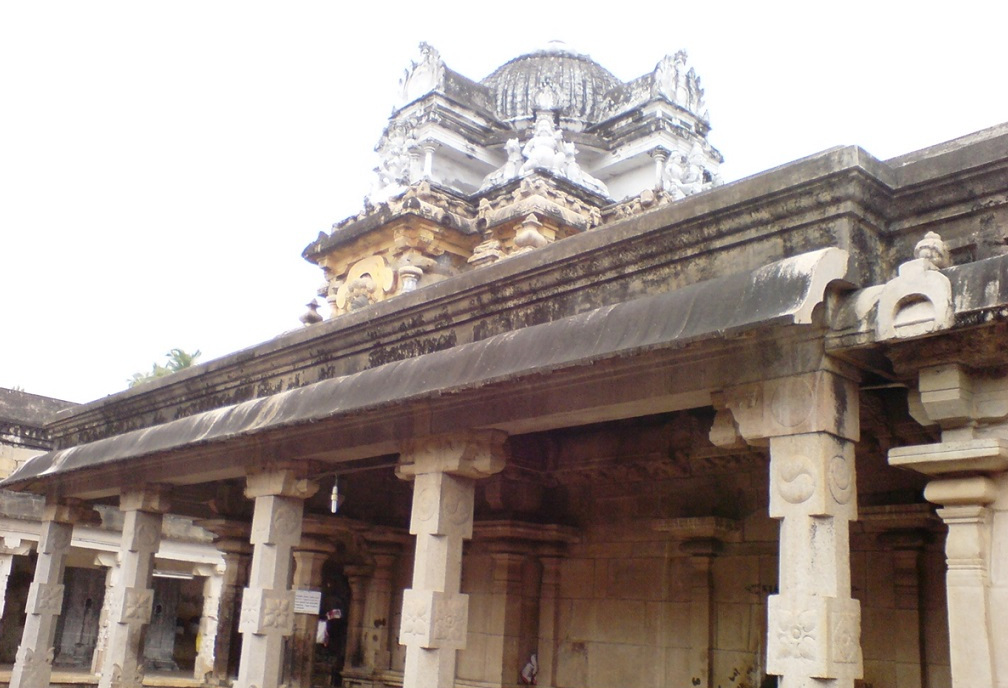Sivayoginathar Temple also known as Yoganandeswarar temple is located in Thiruvisanallur in Thanjavur district, Tamil Nadu, India. The temple is incarnated by the hymns of Thevaram and is classified as Paadal Petra Sthalam. The temple is considered 43rd of the Tevara Stalams in Chola Nadu located North of the river Cauvery.
Shrine’s History
Thiruvisanallur can be traced to the time of the Medieval Cholas having 97 inscriptions dating back to Parantaka I,Rajaraja Chola I and Rajendra Chola II. Two temples, Sivayoginathar and Karkadeswarar, near Kumbakonam, are believed to be storehouses of information. As if refurbishing the spiritual trail blazed by Sridhara Venkatesa Ayyaval, Sadasiva Brahmendra and Sadguruswamy, who spread the bhakti cult of Nama Siddhanta and bhajana paddathi throughout the Thanjavur delta during the rule of Sahaji II (1684-1712 A.D) and his successors, are the shrines of Sivayoginathar and Karkadeswarar, which bear the legacy of having been sung by Thirugnanasambandar alone. Both these temples are a must to visit especially when one takes part in the annual Ayyaval utsavam in the Tamil month of Karthigai or at any time of the year.Thiruvisanullur, now part of Thiruvidaimarudur block, lies at a distance of eight kilometers to the east of Kumbakonam on the northern side of the River Cauvery. It went by the name of Sahajirajapuram after Sahaji II who donated it to 45 pandits.
Legends Associated with This Shrine
A king belonging to present day Kerala had illicit relation with a lot of women. He also tortured and cheated many of them. At one stage, the king wanted to restore to a decent life and found a yogi who advised him to visit Thiruvisanallur. The king reached the place, had a dip in river Cauvery and worshipped Sivayoginathar to get rid of his curse. The legend leads to the belief that whoever incurs the curse of women, get curative visiting the temple. According to another legend, Nandi (the sacred bull of Shiva) got rid of Yama (Hindu god of death), who was approaching a worshipper of Shiva. This legend leads to the belief that a visit to the place is curative to death-related fears. Legend has it that a yaksha who mimicked the gait of Sage Durvasa, noted for his irascibility, was cursed to be born as a crab in the above theertham and worship Siva with lotus flower for the curse to be lifted. At the same time, Indra was said to be offering puja daily to the Lord with 108 lotus flowers plucked and supplied by Varuna. As days wore out, Indra noticed one flower missing in his count and thereupon he traced the missing flower to the claws of a golden crab. Instead of killing it, he traced its path which led to the lingam. Before Indra caught it, it made a hole into the lingam and vanished. It is averred that after performing special ablution to the Siva lingam, the golden crab could be seen. However in the sanctum sanctorum, just above the lingam and to its side the configuration of the crab and its pathway are well etched in stone. The story of Durvasa is engraved on one of the pillars in the anterior hall.
By Road
Thiruvisanallur is on the Suryanar – Thirumangalakudi – Swamimalai Road. Travelling time from Kumbakonam to Thiruvisanallur is around 11 minutes. A taxi or auto can be hired from Kumbakonam.
By Rail
Tirunagesvaram Rail Way Station, Tiruvidalmarudr Rail Way Station are the very nearby railway stations to Thiruvisanallur. How ever Thanjavar Rail Way Station and Kumbakonam Rail Way Station are major railway station near to Thiruvisanallur.
By Air
Kumbakonam has located around 6 KM away from Thiruvisanallur. Kumbakonam does not have an airport. Kumbakonam is 77 km away from Civil Airport (TRZ), Tiruchirappalli, Tamil Nadu.Kumbakonam is 108 km away from Pondicherry Airport (PNY), Puducherry, Pondicherry.
Events Celebrated at This Shrine
The Sunlight Pooja on Chithirai 1, 2, and 3 is a significant one. On the last day of the Aipassi month, the Panca moorthis go on procession Theerthavaari at Kaveri. Aarudra Darshan on the Maha Sivarathiri Day. Other celebrations are on Pratosham, Thirukkaarthigai and on the Karthigai Somavaaram (Mondays).
